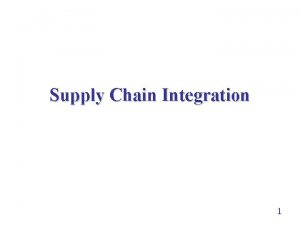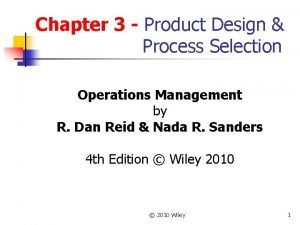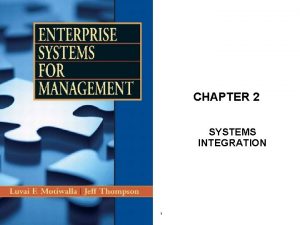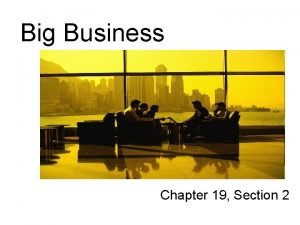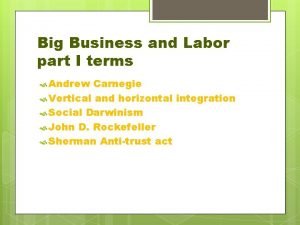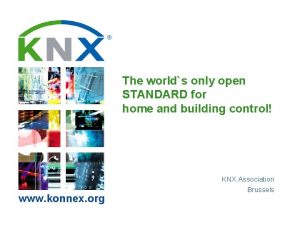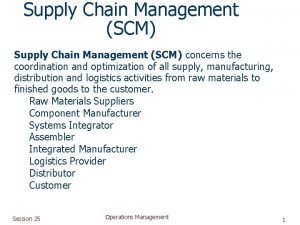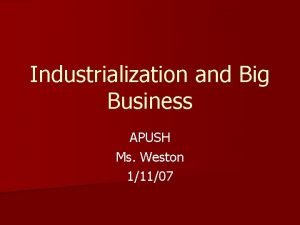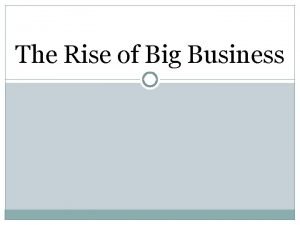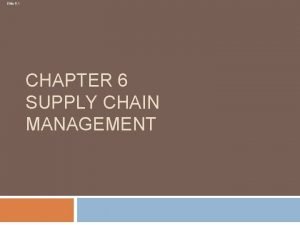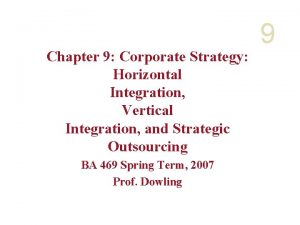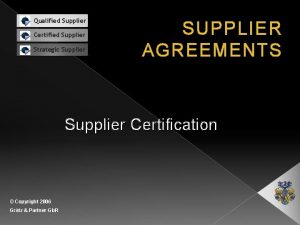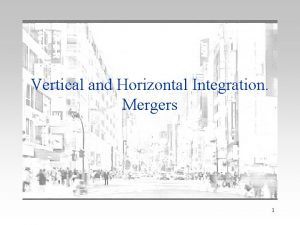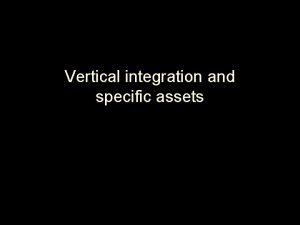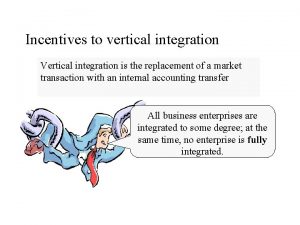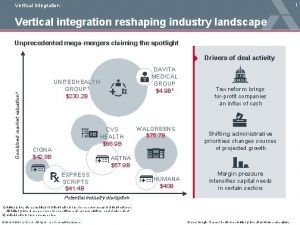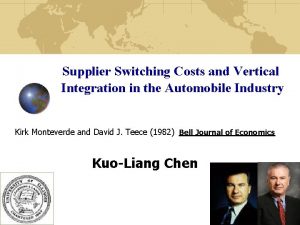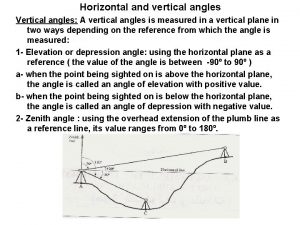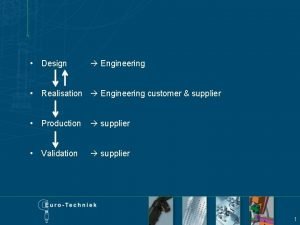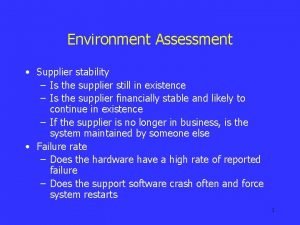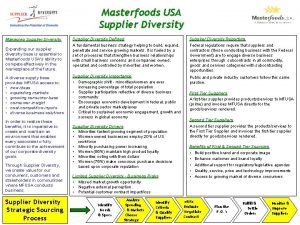Issues in Vertical Integration Vertical NonIntegration Supplier 1






























- Slides: 30

Issues in Vertical Integration

Vertical Non-Integration Supplier 1 Supplier 2 Supplier 3 Upstream The Firm Distributor 1 Distributor 2 Consumers Distributor 3 Downstream

Vertical Integration Supplier 1 Supplier 2 Supplier 3 Upstream The Firm Distributor 1 Distributor 2 Consumers Distributor 3 Downstream

Problems Facing the Non– Integrated Firm n n Double marginalization Hold-up & other bargaining problems Threat of vertical foreclosure Downstream free-riding

Market-Power Pricing: A Review $/unit MC p* CS profit DWL Demand Q* Quantity MR

Double Marginalization n Consider two independent firms, upstream and downstream, that each have market power (i. e. , perceive themselves as facing downward sloping firm-specific demand). n n n Each firm then prices at a mark up over marginal cost. Recall that pricing above MC yields deadweight losses Now these are being incurred twice!

Double Marginalization n n If upstream and downstream merge, then upstream ceases to try to capture surplus from downstream. Upstream prices (transfers) at MC. One deadweight loss eliminated. Like picking money up off the table!

A Digression: Transfer Pricing n n Within a firm, goods should always be transferred at marginal cost (otherwise firm imposes a deadweight loss on itself). Note marginal cost needs to be calculated using opportunity cost.

Example n n Upstream division incurs constant production marginal cost of $1 per unit. Upstream division also sells outside the firm at a price of $4 per unit. If upstream division operating at capacity, then transfer price = $4, since that’s the opportunity cost of internal transfer. Decision is who not whether! If not at capacity, then transfer price = $1, the production MC. Decision is whether not who!

Competitive Markets & Double Marginalization n n If the upstream supplier is in a competitive mkt. (alternatively, in the Bertrand trap), then it prices at MC. Consequently, no deadweight loss. Impossible to get good for less. Double-marginalization (i. e. , transferpricing) justifications for merging do not apply.

Comp. Mkts. & Double Marg. n n n If downstream is competitive, then it’s pricing at MC. It’s, therefore, not creating one of the two deadweight losses. Hence, there’s nothing to pick up off the table vis-à-vis double marginalization— again not a motive to merge.

Hold-ups & Bargaining Issues n n n Firms often need to make transactionspecific investments. E. g. , a mold built to stamp out GM fenders can’t be used for Ford fenders. This creates the danger of hold-up (opportunism). ØAfter one firm (e. g. , Fisher Body) makes investment, investment is sunk and subsequent bargaining w/ other firm (e. g. , GM) could lead to returns that are too low.

Example n n n n Upstream invests $12 million on transactionspecific investment. MC for upstream for parts is $10. A million units to be traded. Downstream’s value is $30/part. Surplus from post-investment trade = $20/unit. Suppose bargaining splits surplus evenly, then upstream gets paid $20/unit; so gross profit is $10 million. But this is less than investment cost!

Contractual Solutions n n Obviously, should fix price in advance at $22 or more per part! But in many cases this will create agency problems. ØIf quality, delivery time, etc. , matter, what incentive does upstream now have to do good job given guaranteed price? ØBut w/o guaranteed price, upstream subject to hold-up.

Example: Disney & Pixar n n n Disney wants Pixar to make computeranimated film, Toy Story, which Disney will market. Given Disney’s expertise in mkt’ing animated films, relationship makes sense. What contract to write?

Disney & Pixar (cont. ) n n n If Disney fixes price in advance, then Pixar’s incentives are blunted. If parties wait to negotiate price after Pixar produces film, then Pixar’s incentives better, but now problem of hold-up. Possible solution: option contract.

Option Contract n n n Contract fixes price if trade, but gives Disney right to refuse to trade. If Pixar doesn’t make sufficiently good film, then Disney lets its option to buy expire. If Pixar does make sufficiently good film, then Disney will want to exercise.

Renegotiation n A problem with any contract is that it can be renegotiated. Hence, if outcome arises in which exercising contract as written would leave surplus on table, then parties will renegotiate. However, the anticipation of renegotiation can distort ex ante incentives.

Renegotiation n n This can undo the option-contract solution What ultimately matters is which of two effects dominates Øhold-up effect Øthreat-point effect

Threat-point Effect n n Our assumption of wholly specific investment is often unrealistic—good could have a lower, general value (e. g. , Warner Bros. could mkt. Toy Story). Does gen’l value increase more at margin w/ investment than specific value? If so, threat-point effect dominates and efficiency can be achieved. If not, hold-up effect dominates and inefficient outcome.

Other Solutions to Hold-up n Keep markets thick: Øharder to be held up if you have alternative suppliers or distributors to use. Øadditional benefits of diversification (e. g. , not hosed if supplier’s factory burns down). n Develop reputation for cooperation rather than opportunism. Øworks if PDV of cooperate > PDV of opportunism today and non-cooperation tomorrow.

Reputation payoff cooperate opportunistic 0 1 2 . . . time

Merge to Avoid Hold-up n n Merger serves to limit danger of hold-up Merger, however, doesn’t miraculously cure agency problems. Østill need to provide incentives to upstream & downstream managers Ødangers in how this is done (e. g. , could be mistake to turn upstream into profit center —usually better to make cost center).

Vertical Foreclosure n Market power in one stream can be extended to another through vertical foreclosure. U 1 D 1 U 2 D 3

Vertical Foreclosure U 1 D 1 U 2 D 3 D 2 and D 3 at cost disadvantage, since U 2 has market power. U 2 may not do as well as U 1 because of double marginalization.

Vertical Foreclosure n Also deters entry Ølocking up suppliers Ølocking up buyers n Not surprisingly, vertical mergers also receive antitrust scrutiny.

Downstream Free-riding n n n Suppose downstream is retail level. Two retailers: Øone provides customer information on product, customer service, etc. Øother just sells product w/o doing any of that. Problem: Øthe 2 nd has cost advantage and can charge lower price Øcustomers get info. , service, etc. from 1 st, but buy from 2 nd.

Free-riding n n n 1 st retailer can’t compete unless drops services. But this could hurt manufacturer in terms of decreasing overall demand for product. Solution: Øforce all retailers to charge same price (resale price maintenance) ØProblem: RPM is generally illegal

Free-riding n n n Consequence: May have to merge into retailing to preserve service, etc. Consequence: Franchising (some problems) Consequence: Provide alternative motives for retailers to keep margins up. Øparticipation in joint advertising campaigns Øtreatment (e. g. , how fast restocked, etc. ) Øability to carry product at all (e. g. , drop those not providing service)

Problems Facing Integrated Firm n n n Detraction from core competencies. Difficulty of selective intervention. Incompatible cultures. Product market is a very good incentive device—hard to duplicate internally. Financial markets are very good incentive devices—hard to duplicate internally. Captive market can inhibit innovation.
 Upstream vertical integration
Upstream vertical integration Supplier onboarding and integration
Supplier onboarding and integration Three dimensions of corporate strategy
Three dimensions of corporate strategy Vertical diversification example
Vertical diversification example Simultaneous integration examples
Simultaneous integration examples The rise
The rise Walmart vertical integration
Walmart vertical integration Vertical integration ap human geography
Vertical integration ap human geography Vertical integration
Vertical integration Process design in operations management
Process design in operations management What is functional silos in system integration
What is functional silos in system integration Andrew carnegie vertical integration
Andrew carnegie vertical integration Andrew carnegie vertical integration
Andrew carnegie vertical integration Andrew carnegie vertical integration
Andrew carnegie vertical integration Horizontal marketing systems
Horizontal marketing systems Vertical integration
Vertical integration Vertical integration
Vertical integration Impact of vertical integration
Impact of vertical integration Vertical integration
Vertical integration Jollibee vertical integration
Jollibee vertical integration Jay gould apush definition
Jay gould apush definition Rockefeller and horizontal integration
Rockefeller and horizontal integration Standard oil octopus cartoon
Standard oil octopus cartoon Vertical integration gilded age
Vertical integration gilded age Vertical integration supply chain
Vertical integration supply chain Disadvantages of horizontal integration
Disadvantages of horizontal integration Vertical integration
Vertical integration Ssush
Ssush Vertical and horizontal integration worksheet
Vertical and horizontal integration worksheet Taper integration
Taper integration Vertical integration
Vertical integration






